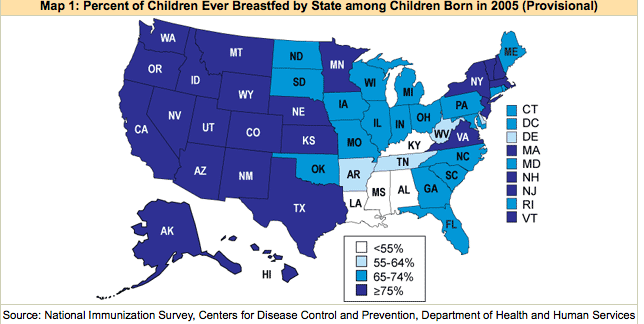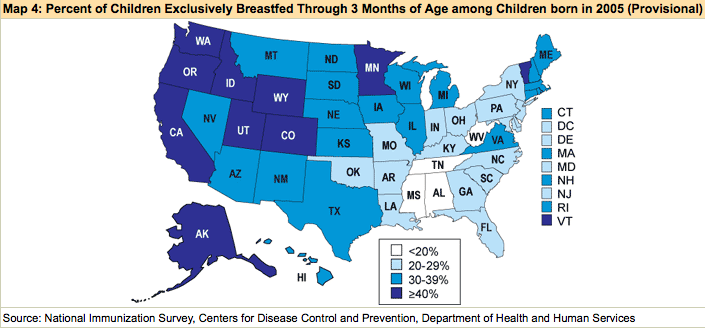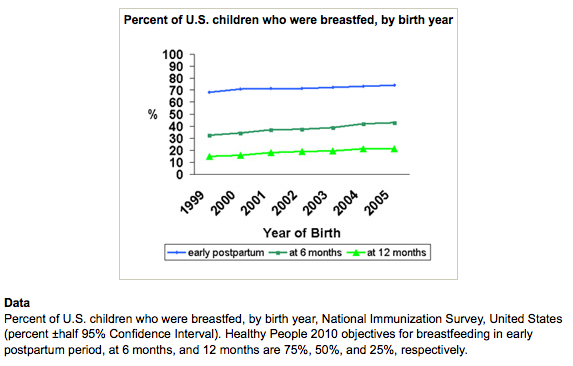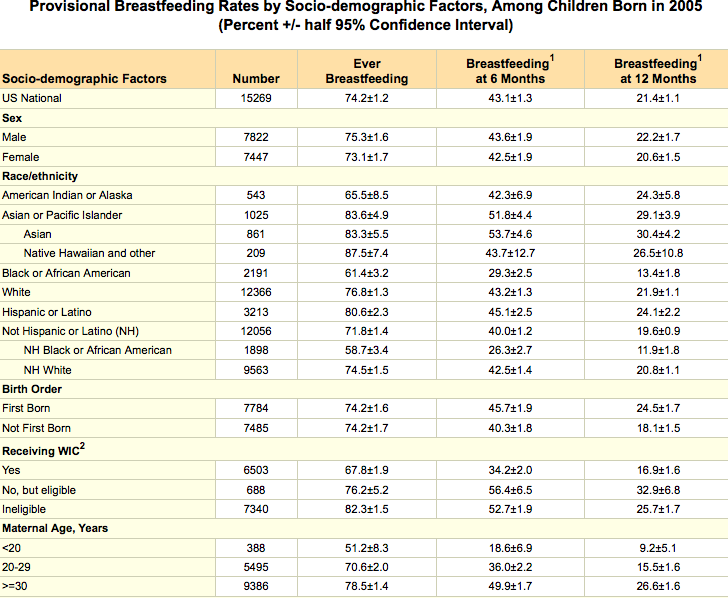We’re talking about the medicalization of pregnancy and the natural childbirth and breastfeeding movements in my Women’s Studies class, so here are some data on rates of breastfeeding in the U.S., which you might use for a discussion of ideals of motherhood, medicalization, and the difficulties of integrating breastfeeding with full-time work. The regional patterns are also fascinating.
This map shows the percent of children born in 2005 ever breastfed at all (including those supplemented with formula):
This one shows the percent of children who were only breastfed (no formula supplementing) for the first three months:
And here we have the rates of exclusive breastfeeding up to 6 months. Notice how low the rates are, with many states having 10% or less of children breastfed exclusively for that long:
Here are overall rates:
And overall rates of kids ever breastfed, including with formula supplementing:
About 25% of babies are supplemented with formula within the first 48 hours:
Here’s a whole lot of information on rates of breastfeeding:
In general, higher incomes are associated with higher rates of breastfeeding, which probably partially explains some of the other patterns (regional, race, etc.). My guess is many people will attribute this to cultural factors–the idea that highly-educated women with higher incomes have access to more information about breastfeeding, are more aware of how important it is, and have more access to support systems that encourage breastfeeding. I suspect part of it is also that some women–particularly those with higher incomes–are more able to take time off work to stay home for at least a short while, making breastfeeding easier. Of course, the paradox there is that the very families who can least afford expensive formula are most likely to use it.
All images found at the Centers for Disease Control and Prevention’s breastfeeding website.









Comments 7
SarahMC — December 5, 2008
Wow, it makes me sad that the rates are so low. It's particularly depressing that women in the very poorest states (the deep south) are not taking advantage of a free food source for their babies (or aren't being encouraged and taught how to).
Tracy — December 5, 2008
I wonder how much the numbers are skewed by doctors recommending supplemental feeding. I know when I was a baby, my mother used supplemental feeding because I wasn't gaining enough weight.
Gwen — December 5, 2008
Tracy--the CDCP site has links to a couple of different studies, and one of the results from a survey they've been conducting was that while hospitals support breastfeeding IN THEORY, in reality they do not provide sufficient support to help women breastfeed. So there's a disconnect b/w the whole "breastfeeding is best" message and what actually happens in hospitals, where doctors tend to get nervous if a baby won't breastfeed right away and worry about lawsuits, so encourage supplementing. That's a likely reason why so many babies are supplemented within the first 2 days--before the mother has even left the hospital.
Duran — December 6, 2008
I've had it up to fucking here with the south. What a bunch of backwards dumbshit ignorant hicks. Politically, economically, culturally and socially they are pulling this country back to the 1950s.
The South — December 7, 2008
Thanks, Duran!
Rates of Breastfeeding by Race and Education » Sociological Images — April 28, 2010
[...] on rates of breastfeeding, including U.S. state comparisons and changes in rates over time, see here. var addthis_language = 'en'; Leave a Comment Tags: class, education, gender: [...]
The rate of breastfeeding in the u.s. - Pelican Parts Technical BBS — May 30, 2015
[…] […]